

July
2021
|
Search the FOA website
FOA
Home Page Contact
Us
|
Sign
up for the FOA eMail Newsletter
Privacy
Policy
Sections
News
Technical
Worth Reading
Q&A Training/FiberU
Resoures
Safety
About
|
- In
This Issue
- Note
we have changed the format to place articles in
sections on one topic and all articles are dated so
you know if we repeat one - whcih we often do when
we think it's very important!
July
Is also FTTH Month
New
FOA FTTH Handbook
New FOA FTTH Tech Materials
4 New FTTH Video Lectures
Updated FTTH Course at Fiber U (AND FREE)
Broadband in California
FOA OJT-to-Cert Program
Newsletter
Sections
Click
on any link to jump to that section
News
Perils
of Aerial Cable
Mapping
Broadband in the US
Fiberminded Interviews FOA President
Fiber Tech In Crash Test Dummies
Can Facebook Disrupt Wireless?
Market Tape That Works
Lightwave is Back
New Submarine Cable Map
Technical
Why Isn't My FTTH Faster?
Properly Managed Fiber Pedestal
Reusing Older Equipment
Rural FTTH Architectures
What Does "Telephone Symbol" Mean?
Are 850 LEDs Extinct?
Grounding Rules
Loss Budget Calculator
Worth
Reading Lots
of interesting articles
Q&A
Questions from our readers
Training/FiberU
New Fiber U MiniCourses, schools, remote OTDR
for training, making training classroom safe, onine
training, materials, more
Resources
New FOA YouTube Videos. Safety
About
FOA Certifications:

Time
To Renew Your FOA Certifications?
Special
offer - 1/3 Off Renewal
Jobs
- See
FOA Jobs
Web Page and FOA on

- The
FOA Jobs
Web Page has been updated and a new page added on Using
your FOA Training/Certification to Find the Right Job
in Fiber Optics
Where
Are The Jobs In Fiber Optics? FOA talks about all the
applications for fiber optics, what jobs involve and the
qualifications for the workers in the field in this YouTube
video.
Join
The FOA eMail Newsletter List
Want to
be notified when the FOA Newsletter is updated? Sign
up for the FOA eMail Newsletter. You can also
sign up from your cell phone: text "FOA" to 22828 (usual
text message charges apply)
Trademarks:
The FOA CFOT® (Certified Fiber Optic Technician) and
Fiber U® (the FOA online self-study program) are registered
trademarks of the FOA.

Want
to know more about fiber optics? Study
for FOA certifications? Free
Self-Study Programs are on "Fiber
U®." Looking for specific information? Here's the
largest technical reference on the web: The
FOA Online Fiber Optic Reference Guide.
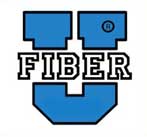
Free
online self-study programs on many fiber optics and cabling
topics are available at Fiber
U, FOA's online web-based training website.
FOA
Reference Books
Available Printed or eBooks
The
fiber book is available in Spanish and French


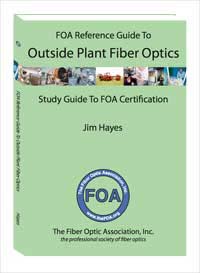
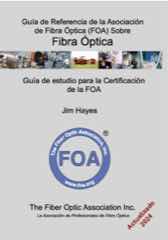
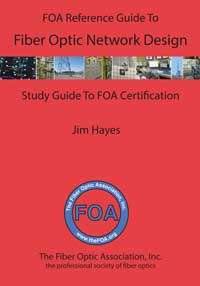



Lennie
and Uncle
Ted's Guides are now also available as free iBooks on
iTunes.

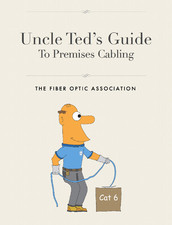
Click
on any of the books to learn more.
- Fiber
Optic Safety Poster to download and print
FOA
Videos on 
FOA
is a member of:





The
FOA Newsletter is edited by Jim Hayes - send your stories,
leads, ideas, comments to <jim @ foa.org>

Search
the FOA Website With DuckDuckGo
- The
Archives: Past Issues.
- Use
these links to read past issues or use FOA's
Custom Search to look for specific topics on our
website.
1/21,
2/21.
3/21, 4/21,
5/21, 6/21,
7/21,
1/20,
2/20, 3/20.
4/20, 5/20,
6/20, 7/20,
8/20, 9/20,
10/20, 11/20,
12/20,
1/19,
2/19, 3/19,
4/19,
5/19, 6/19,
7/19, 8/19,
9/19, 10/19,
11/19,
12/19
1/18,
2/18, 3/18,
4/18, 5/18, 6/18,
7/18, 8/18,
9/18, 10/18,
12/18.
1/17,
2/17, 3/17,
4/17, 5/17,
6/17, 7/17,
8/17, 9/17,
10/17, 11/17,
12/17
1/16,
2/16, 3/16,
4/16,
5/16, 6/16,
7-8/16, 9/16,
10/16, 11/16,
12/16
1/15,
2/15, 3/15,
4/15, 5/15,
6/15, 7/15,
8/15, 9/15
, 10/15,
11/15 , 12/15
1/14,
2/14, 3/14,
4/14, 5/14,
6/14, 7/14,
8/14, 9/14,
10/14, 11/14,
12/14
1/13,
2/13, 3/13,
4/13, 5/13,
6/13, 7/13,
8/13, 9/13,
10/13, 11/13,
12/13
1/12
, 2/12, 3/12,
4/12, 6/12,
7/12, 8/12,
9/12, 10/12,
11/12, 12/12
1/11
, 2/11,
3/11,
4/11,
6/11, 7/11,
8/11, 9/11,
10/11, 11/11,
12/11,
1/10
, 2/10,
3/10, 4/10,
05/10,
07/10,
08/10, 09/10,
10/10,
11/10
1/09
, 2/09,
3/09, 04/09,
05/09,
07/09,
08/09, 09/09,
10/09, 11/09,
12/09
1/08
, 2/08, 3/08,
4/08, 5/08,
6/08, 7/08,
8/08, 09/08, 10/08,
11/08, 12/08
12/07 , 11/07,
10/07, 09/07,
08/07, 07/07,
06/07, 05/07,
04/07, 03/07,
2/07, 1/07
12/06
, 11/06, 10/06,
09/06, 8/06,
7/06, 6/06,
5/06, 4/06,
3/06, 2/06,
1/06,
12/05
,11/05, 10/05,
09/05, 08/05,
07/05, 6/05,
5/05, 4/05,
2/05, 01/05,
12/04
, 10/04, 9/04,
8/04, 7/04,
6/04, 5/04,
4/04, 3/04,
1/04,
12/03
, 11/03 10/03
9/03, 8/03,
7/03, 6/03,
3/03, 10/02
, 8/02, 5/02
Current Issue of FOA Newsletter
Time
To Renew Your FOA Certifications?
To keep
your FOA certifications active, you need to renew them when
they expire. Now we have a new more convenient way to renew
- an online store at Paypal - where you can quickly and
conveniently use your PayPal account or your credit card to
renew your certifications.
- You
can now renew with PayPal or a credit card
-
PayPal
is available worldwide
Join
FOA On Social Media

FOA has
four LinkedIn Groups
FOA
- official page on LinkedIn
FOA
- covers FOA, technology and jobs in the fiber optic
marketplace
FOA
Fiber Optic Training - open to all, covers fiber optic
technology and training topics
Grupo
de La Asociación de Fibra Óptica FOA (Español)
SPECIAL
OFFER - 1/3 Off Your Certification Renewal Cost
In the
near future, there will be a requirement for continuing
education to renew your FOA certifications. FOA is testing
an option for renewals where you take a short Fiber U online
course.
If you would like to help FOA test this option, you can save
1/3 the cost of your renewal. Go
here to take the Fiber U CFOT Renewal Course: |
FOA
Newsletter - Features
July
Is ALSO "FTTH Month" In The FOA Newsletter
Last
month we focused on FTTH in the FOA Newsletter but we
have more to add this month too. We'll start off with
our new "FTTH Handbook," talk about updates at Fiber U
and include some more information we find interesting.
Discussions
going on everywhere about how we've learned during the
pandemic that broadband is a necessary utility and there
is a need to expand broadband to everyone. If you read the
same newspapers, magazines and newsletters we do, you are
hearing daily how various organizations, often local
governments, coops or citizens groups, are organizing to
develop their own broadband networks. (See the California
report below.) All of these networks require fiber optic
backbones and most are developed around fiber to the home
(FTTH.)
New
FOA Book - The FOA FTTH Handbook

FOA's
FTTH Handbook: We've gathered all our
information on FTTH from the FOA Guide and past issues of
the FOA Newsletter and edited it into a "FTTH Handbook."
This large (8.5X11")
112 page book is full of information on FTTH to help you
understand it and be more effective at implementing FTTH
projects.
This
FTTH Handbook is not just for technicians working on FTTH
networks. It's even subtitled: For Planners, Managers,
Designers, Installers And Operators Of FTTH - Fiber To
The Home - Networks. We even added a section on
planning and managing FTTH Projects for them.
So
if you are involved in a FTTH project or are considering
starting one, this book is for you too.
The
Fiber Optic Association Fiber To The Home Handbook
is available from Amazon in print ($19.95) and Kindle
($9.95) editions.
Workforce
Development
We,
the fiber optic industry, have a problem. There are simply
not enough qualified techs to build all these FTTH (and all
the other) networks on a timely basis. FOA has been
addressing this issue for our entire history - it began with
our charter "to enhance professionalism in fiber optics
through education, certification and standards."
Following our focus on educations, we've published 7 of our
own books (11 if you include translations), created
nearly 1000 pages of technical content online
in
the FOA
Guide and offer over two dozen free online self-study
courses on Fiber
U.
Here's
the latest at Fiber U, our updated and expanded FTTH
course:
FTTH
Online Training
FOA has
updated the free Fiber
U FTTx self-study course, added lots of tech material
and added a completly new lesson on FTTH Design. This uses
the new materials created for the FOA Guide and FOA YouTube
channel. And for a limited time you can take the Fiber U
Certificate of Completion test FREE when you complete the
course. See details below.
The
Fiber U FTTH Course IS COMPLETELY FREE!

Take the Fiber U FTTH course
and Certificate Test FREE until September 30, 2021!
Fiber U self-study courses themselves have always been
free, but we have charged for the Fiber U Certificate of
Completion test which uses an online testing service. So
everyone can take advantage of all the new and updated
FTTH materials we've created, FOA will offer the testing
for the Fiber U Certificate
of Completion for the Fiber
U FTTx self-study course free to everyone
completing the course until September 30, 2021. Tell
your employees, customers, everybody!
That means companies can have their workers get started
on OJT using the new FOA program at
no cost - the course is free and the certificate is
free.
FTTH
Updates In The FOA Guide And YouTube
FTTH
has always been the most popular application for FOA's
knowledge base. The subject is a major topic in the FOA
Guide and the Fiber U FTTH course has been very popular.
Many of our FOA approved schools use the FOA curriculum and
teach combination courses for CFOT/CFOS/H for techs and
CFOS/D (design) and CFOS/H for designers.
As with all topics in the FOA knowledgebase, we try to keep
up to date, incorporating the latest developments and trends
to ensure our materials are most useful to the industry.
Over the last few months, we've been working overtime to
update FOA materials covering FTTH. Along the way, we've
found out about some new products and applications that are
important for network owners and managers, designers,
installers and operators to be familiar with, as they can
help build FTTH networks that are better, cheaper and easier
to design, build and operate.
Technical
topics
we've updated and expanded include 10G PONs and FTTx
architectures for urban, suburban and rural networks. In
doing so, we uncovered a new product that can make rural
FTTH much more feasible and cost effective - a small OLT for
remote locations (see article below). We've examined some
architectures being used in the real world that are
different but work better in some particular geographic
locations - e.g. putting all the splitters in the CO/head
end and running a fiber to every subscriber. We'll expand on
those topics later in the Technical
section of this newsletter.
Here's what we've created and updated recently:
FOA
Guide: Added a section on FTTH Network Design, updated
sections on Architecture and PONs (including 10G)
FOA's
YouTube Channel: Added 4 new FTTH videos on Network
Architecture, PONs, Network Design and Installation/Test.
How Can These New Materials Benefit You?
- Update
your knowledge: Even if you already have your
CFOS/H or have completed the FTTx self-study course on
Fiber U, we recommend you go back to the Fiber U course
on FTTH Network Design and take the architecture, PON
and Design lesson again.
- Getting
Started in FTTH: We recommend buying a copy
of FOA's
FTTH Handbook or going straight to
the Fiber
U FTTx self-study course which will get you
started right most quickly.
- Learning
More About Special Topics in FTTH: Read
the new/updated pages on the FOA Guide and watch the
new videos.
- Designing
FTTH Networks: If you are involved in the design
of FTTH networks but new to fiber optics, start with
the Fiber U Fiber
Optic Network Design course then take the Fiber
U FTTx self-study course.
- Teaching
FTTH Courses: If you are already an FOA-approved
school, download the new updated curriculum. Not an FOA
School? Contact FOA.
- Employee
OJT
What's Next?
Our
next project is to use these new/updated training materials
to help train more techs.
- Training
at FOA approved schools: We will of course
work through the FOA network of approved schools, many
of which already teach FTTH courses.
- OJT
(On the job training): We will also be
reaching out to network owners and managers and their
contractors who can use all these free materials for OJT
- on the job training - for their workers.
FTTH
Tech Update
While
doing all the research for this major update of the FOA FTTH
technical materials and FOA online course, we discovered
some interesting things about FTTH. In particular, rural
FTTH has been an issue because the low density of
subscribers and long distances between them makes costs much
higher.
From the June 2021 newsletter - moved
to the Tech section below.
Broadband
Internet in California - Lots to Learn For Everybody,
Everywhere
One
expects the state of California with all it's high tech
industry to be aware of the state of broadband Internet in
the state. A state commission has completed a survey and it
is most interesting. Here are some of the highlights with
emphasis by your editor:
California
Broadband Council - The Current State of Broadband in
California
California Broadband Council developed the
“Broadband for All” Action Plan with the understanding that
broadband access, adoption, and training are essential
components of digital equity. The Council
solicited extensive engagement and input from state and
local agencies, state legislative leaders, tribal nations,
broadband industry leaders, nonprofits, and members of the
public.
This Plan focuses on achieving three long-term goals:
All Californians have high- performance broadband
available at home, schools, libraries, and businesses;
All Californians have access to affordable broadband and
the devices necessary to access the internet; and All
Californians can access training and support to enable
digital inclusion. To achieve these goals the
California Broadband Council plans to leverage the state’s
full range of tools, including policy, programs, funding,
partnerships, and collaborations with federal, local, and
tribal governments.
According to the most recent figures, 23 percent of
California housing units—home to 8.4 million
residents—do not have broadband subscriptions.
At the end of 2018, broadband services that advertised
download speeds of 100 Mbps or greater were available to
nearly 95 percent of California households. This achievement
reflects widespread cable and fiber deployment in dense
urban areas.
Nevertheless, many homes in urban areas remain
unserved or do not have access to the same
broadband infrastructure (especially fiber) that is
available to wealthier neighbors, illustrating a historical
pattern of uneven investment. In addition, in rural
California less than half of households (46.5 percent)
can adopt broadband at this speed.
Approximately 674,000 households in the state lack
high-capacity broadband, with about 305,000 located in urban
areas and 369,000 located in rural areas.
The geographical challenge is immense.
Consider that urban California covers nearly 8,200 square
miles and contains almost 95 percent of the state’s
population. Rural California is home to 5 percent of the
population spread across 147,000 square miles—an area larger
than the combined land areas of Delaware, Maine, Maryland,
Massachusetts, New Hampshire, New Jersey, Rhode Island,
South Carolina, Vermont, and West Virginia.
(CA overall is only 163,696 square miles - so 5% of
the population is in 90% of the state by area while 95%
of the population is in the other 10%. The
rural broadband challenge is indeed immense. ed)
Challenges
to Achieving Broadband for All
The
Council identified five core roadblocks preventing
Californians from accessing or adopting broadband:
availability (speed and reliability), affordability, access
to devices, digital skills, and data.
- Challenge
1: Availability (speed and reliability)
- Challenge
2: Affordability
- Challenge
3: Devices (In 2019, only 82 percent of California
households had a desktop or laptop at home.)
- Challenge
4: Digital skills
- Challenge
5: Data
Goals For Broadband in California
From Obstacles to Opportunity: California’s Broadband Goals
- Goal
1: All Californians have high-performance broadband
available at home, schools, libraries, and businesses.
- Goal
2: All Californians have access to affordable broadband
and necessary devices.
- Goal
3: All Californians can access training and support to
enable digital inclusion.
You
can download and read the complete plan here: California
Broadband Council - The Current State of Broadband
in California
Job
Opportunity At A Regional FTTH Project - Executive
Director

Lamoille
FiberNet Communications Union District seeks a
full-time Executive Director to lead and manage its work in
building a community-based fiber network and bringing high
speed symmetrical broadband service to its communities.
If you would like to work with a board that is hard-working
and passionate about bringing fiber broadband to its region,
and you have excellent leadership and communication skills,
strong knowledge of telecommunications or technical
expertise, and have experience with non-profit boards, this
multi-faceted position could be a great fit. Competitive
compensation package. Join us!
Complete job description at www.lamoillefiber.net.
To apply, send cover letter and resume to
<jcampbell@lamoillefiber.net>. No phone calls, please.
FOA/Fiber
U On-The-Job Training (OJT) Program
OJT
is the well-known term for "on-the-job training." Workers
learn on the job under the supervision of experienced
co-workers. FOA has been asked many times how its resources
like Fiber U can be used to help employers and their
employee trainees involved in OJT. The interest in OJT has
been so high, especially during the difficult year in 2020,
that FOA has worked with employers and employees to
formalize an OJT program and create training aids to help
employers develop qualified techs using OJT.
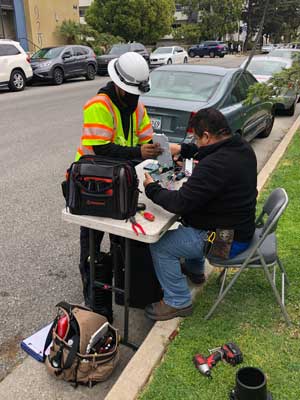
The
FOA
Fiber U “OJT-To-Cert” program includes
both fiber optics and premises cabling (copper, fiber &
wireless), so it covers techs working in both outside plant
and premises jobs.
The
FOA Fiber U OJT program combines online study at Fiber
U with OJT with mentoring by experienced co-workers
and their supervisor to help new employees
develop into FOA-certified technicians in only one
year. Upon completion of this
program, the trainee will be prepared to take the exam for
the FOA CFOT (Certified Fiber Optic Technician) and/or
CPCT (Certified Premises Cabling Technician), the most
widely recognized fiber optic and premises cabling
certifications in the industry.
Like
other FOA programs, the OJT-To-Cert program is free. The
FOA provides directions for use of the free Fiber U online
training programs and we provide a log for the trainee to
keep track of their progress. The only cost is the two
Fiber U certificates of completion and the FOA
certification exam at the end of the program.
If
you and/or your company is interested in the FOA
OJT-To-Cert program, contact FOA.
New
FOA
YouTube Video Describes On-The-Job Training (OJT) With
Fiber U
To
explain How OJT works and FOA's OJT-To-Cert program, FOA
created a short 10 minute YouTube video that explains what
OJT is, who uses it and how to use Fiber U to organize and
enhance OJT for new employees and experienced workers too.
Lecture
62: On The Job Training For Fiber Optics Using Fiber U
FOA
Newsletter Sections
News
Technical
Worth Reading
Q&A Training/FiberU
Resoures
Safety
About
|
News
Lots
more news in Worth Reading below
|
Perils
Of Aerial Cable - Truck Breaks Low Hanging Cable In St.
Louis Alley
FOA
instructor Milt Murry lives in St. Louis and often sends us
photos of installations in the area. He sent us these photos
of a broken 144 fiber ribbon cable in an alley near his
home.

The broken cable was taped to a utility pole in the alley.
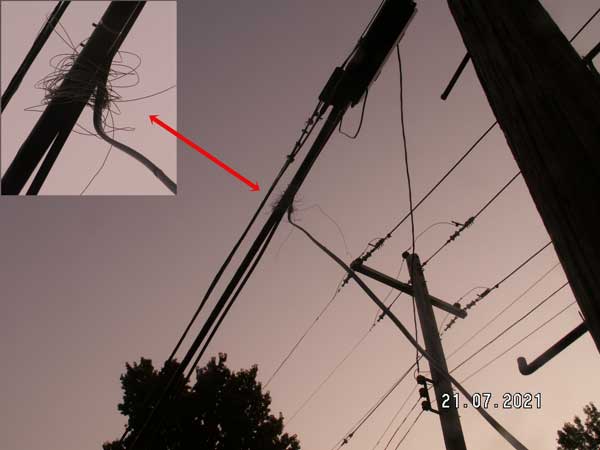
Looking
up from the coil of cable you can see where it was ripped
off the messenger under enough stress to leave it
permanently kinked.
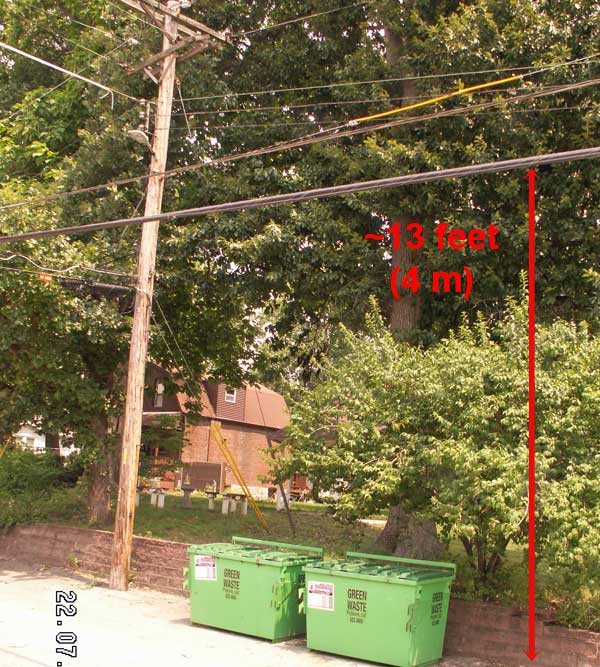
This
may be the reason. Milt measured the cable and it was only
13 feet (4m) high, about 3 feet / 1 m lower than cables are
supposed to be placed. Milt's neighbor, an AT&T employee
saw a large trailer truck going down the alley, so it could
have snagged the cable.
Note the number of cables in the alley, power and telecom,
going in all directions.
NTIA
Creates First Interactive Map to Help Public See the
Digital Divide Across the USA
NTIA
map links poverty usage and broadband access by compiling
data sets to show where high-poverty communities are
located with relation to internet usage patterns and
access to computers and related equipment
The U.S. Department of Commerce’s National
Telecommunications and Information Administration (NTIA)
released a new publicly available digital map that displays
key indicators of broadband needs across the country. This
is the first interactive, public map that allows users to
explore different datasets about where people do not have
quality Internet access.

Map displaying Census tracts where median Internet speeds
show fixed broadband below 25/3 Mbps, according to
Ookla data
The public “Indicators of Broadband Need” tool released
today puts on one map, for the first time, data from both
public and private sources. It contains data aggregated at
the county, census tract, and census block level from the
U.S. Census Bureau, the Federal Communications Commission
(FCC), M-Lab, Ookla and Microsoft. Speed-test data provided
by M-Lab and Ookla help to illustrate the reality that
communities experience when going online, with many parts of
the country reporting speeds that fall below the FCC’s
current benchmark for fixed broadband service of 25 Mbps
download, 3 Mbps upload. This is the first map that allows
users to graphically compare and contrast these different
data sources.
“As we
release this important data to the public, it paints a
sobering view of the challenges facing far too many
Americans as they try to connect to high-speed broadband and
participate in our modern economy,” said U.S. Secretary of
Commerce Gina M. Raimondo.
“Broadband is no longer nice to have. It’s need to have. To
ensure that every household has the internet access
necessary for success in the digital age, we need better
ways to accurately measure where high-speed service has
reached Americans and where it has not,” said FCC Acting
Chairwoman Jessica Rosenworcel. “The latest mapping effort
by NTIA is a welcome new tool that provides valuable insight
into the state of broadband across the country. Kudos to
Secretary Raimondo and Acting Assistant Secretary Remaley
for their leadership. The FCC looks forward to continuing
our close collaboration with the Commerce Department and
other federal partners to fulfill the goal of connecting 100
percent of Americans.”
Here
is the article and the interactive map.
Mapping
Broadband In The US, State By State
Next
Century Cities has completed a survey of broadband in the US
by state because the FCC data is widely known to be
inaccurate. Next Century Cities (“NCC”) is a nonprofit,
non-partisan organization that advocates for fast,
affordable, and reliable broadband Internet access across
the U.S. They work alongside local officials in communities
of all sizes and political stripes to eliminate the digital
divide.
As NCC has documented in filings and publications, the
Federal Communications Commission’s (“FCC” or “Commission”)
maps have long told a different story of broadband access
than what residents across the country actually experience.
It is widely known that the FCC’s broadband availability
data understates the seriousness of, and lacks granularity
to adequately address, persistent gaps in connectivity.
Read
the NCC Report here. Use
this link if you want to jump to the report for a
particular state.
A
New Fiber Optic Shape-Sensing Technology for Crash Test
Dummy Ribs
Most of
the world’s current portfolio of crash test dummies use
thorax rib displacement sensors that give us single point
measurements that do not accurately represent the shape
deformation of the rib cage. Humanetics has teamed up with
Fibercore to design an ingenious new fiber optic rib for the
WorldSID-50M ATD that uses a single optical fiber with
multiple strain measurement nodes to calculate the entire
rib shape.

For
more information: Humanetics
and Fibercore
Can
Facebook Disrupt Wireless Like They Did Data Centers?

Terragraph
is Facebook's wireless system for Internet access. Their Open
Compute Project "open source" designs for data centers
have been very successful because they do the job as well or
better than commercial products at lower cost. Now they are
offering mm wave wireless systems operating on non-licensed
frequencies with the same goal. Unlike point-to-point
wireless, Terragraph creates a mesh network that can be
higher performance and more reliable. The goal is lower
costs for the "last mile" or subscriber connections. Will it
be as successful as OCP? Only time will tell. (Don't worry,
it still needs lots of fiber!)
Learn more about Terragraph.
When
You Bury Marker Tape, Bury One That Will Work

Signaltape®
provides a visual warning by ensuring tape is brought to the
surface, alerting the operator to the presence of a buried
utility. It includes a 3,000-lb. tensile strength aramid
fiber membrane, which ensures the tape is pulled to the
surface to alert the excavation crew. Signaltape
comes in two sizes: 12″ x 1000′ or 6″ x 1000′.
"Become
Fiberminded" Podcast Interviews FOA's Jim Hayes

"Become
Fiberminded" is a podcast series started by
Christian Till, a member of the fiber optic community from
the Netherlands. He's interviewing people in the industry
to have them discuss their work and help others learn from
their knowledge. Here's what he says about Become
Fiberminded:
"WE
HELP PEOPLE THRIVE IN FIBER OPTICS
By interviewing guests who are actively helping the fiber
optics community to solve problems and enable a faster and
better connection for everyone. Each episode contains
powerful information to help you better understand fiber
optic technology, stay on top of the latest trends, and
enable you to efficiently build and maintain future-proof
networks."
For
his series, Christian
interviewed FOA President Jim Hayes. In the
interview Jim discusses the origins of the FOA and it's
goals to serve the fiber optic industry through education,
certification and standards. He also points out some of
the areas which are often confused about fiber optics and
how FOA tries to simplify learning the right way.
Listen
to the Fiberminded Podcast
interview of FOA President Jim Hayes.
Do-It-Yourself
FTTH Is Powerful
Five
years ago in the FOA Newsletter, FOA
featured two broadband projects in areas that
traditional telecom companies shunned, rural areas where
residents wanted broadband and realized that unless they did
it themselves, it was not going to happen. One project was
initiated by a real estate developer with a technical bent,
the other a very rural electrical coop. Since then, we've
worked with or heard about hundreds of these projects. Many
are rural, but others are simply small cities that are tired
of poor Internet service and being ignored by incumbent
service providers. The last year, during the pandemic,
emphasized the importance of broadband and firmly
established it as a necessary utility. It also motivated US
and local politicians to finally look at broadband as an
infrastructure projects that deserve funding. Even venture
capital, famous for throwing vast sums at ridiculous ideas
has begun to invest in broadband.
Just this month, we've seen announcements for projects in
typically tight with the $$$ New England - New
Hampshire and Maine
following Vermont's
lead - (Broadband
Communities.) There are projects along the Appalachian
Trail from Maryland to Georgia (Next
Century Cities.) California
and Maryland
propose statewide funding, Drammen,
WI, Knoxville,
TN and Waukegan,
IL begin working toward projects, and an Oregon
electrical coop and one in Alabama
get started on their project - (ILSR
Community Networks.) And don't forget Kentucky
Wired! FOA schools in the KCTCS system are training
techs who are doing OJT while building the system which is
now >83% complete.
How
powerful is this movement? So powerful that the lobbyists
for the incumbents are back at it, pushing Ohio
to pass laws banning municipal broadband. Just like
Will Rogers, comedian and newspaper columnist wrote almost a
century ago, "America has the best government money can
buy."
Lightwave
Magazine Is Back!

Lightwave
Magazine is back after many years as only a online
newsletter. Lightwave was started in 1984 by Howard
Rausch, a veteran newsman, a gentleman and a scholar!
(JH) We reported on the demise of the printed version of
Lightwave in the FOA
Newsletter of March 2009. Lightwave is back as a
digital magazine, perfect for the times, and still headed by
Editorial Director Stephen Hardy, a veteran of the fiber
optic community with great in-dept knowledge of the
technology, companies and people who make fiber optics what
it is today. Lightwave's
comprehensive website continues too. All very worthwhile
reading.
TeleGeography's
New Submarine Cable Map

TeleGeography's
new 2021 Submarine Cable Map is packed with new
cables and stats. Not to mention the new graphics and
FAQs! This edition is loaded with trivia on cable
suppliers, content providers, deployments, fiber, and
more.
The 2021 Submarine Cable Map depicts 464 cables and 1,245
landing stations; 428 cables are active and 36 are
planned.
Of the planned cables, 19 were not depicted in our 2020
edition. (The combined length of those 19 new planned
cables is 103,348 km!)
|
Technical
On
fiber optic technology, standards, equipment,
installation, etc.
The
FOA Update Page
covers all the new technology and applications we covered
in this newsletter recently. Now you can review all that
new tech at once.

Want
to know more about fiber optics? Study
for FOA certifications? Free
Self-Study Programs are on "Fiber
U®." Looking for specific information? Here's the
largest technical reference on the web: The
FOA Online Fiber Optic Reference Guide.
|
Why
Isn't My New Fiber Connection Faster Than My Previous DSL?
FOA
received an inquiry from a person who had just had a FTTH
connection replace their old copper DSL connection. Their
question was why their new fiber was not much faster than
their old copper Internet connection. We went through how
the network was set up and how they were using it. We
explained how networks
were sharing bandwidth so speeds often depend on the number
of users.
Then we found that they were using a 12 year old computer.
We suggested that the problem could be their computer's
speed. A neighbor tried a few years newer computer and it
was a bit faster. No current computers were available to
test the connection, so we decided to try our own test.
We
use a high end MacBook Pro computer on a cable modem that is
supposed to deliver 200 Mb/s. We ran speed tests and got
these results:
Speedtest results were 14 ms /234 Mb/s down/10 up. Nperf
results were 21ms /235 Mb/s down /11 Mb/s up. I got
basically the same results using Safari and Firefox.
I dug out a 10 year old MacBook Air with 2GB of ram running
OS 10.10.6 and repeated the Speediest.
On Safari. 22ms/75 Mb/s down/11 Mb/s uploading - the
download speed was 1/3 as fast. Using Firefox, it was 24 ms
/39 Mb/s down /11 Mb/s up.Now the download speed is ~1/6 as
fast.
Interestingly, the latency and upload speeds did not change
(neither were very good either), only the download speeds
differed, indicating the gating item was the speed on the
computers.
The conclusion is that to take advantage of the speed of
FTTH, especially those offering Gb/s download speeds, you
need to have the latest hardware. Otherwise the gating item
is your computer.
Here's
A Properly Installed Fiber Distribution Hub
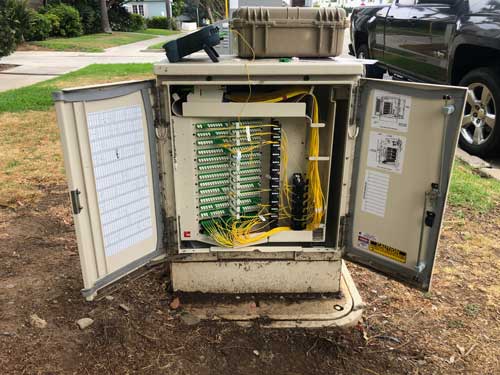
Just around the corner from our office is this FDH installed
by Verizon for FiOS over ten years ago. It shows the rows of
SC-APC connectors available for connections and the
patchcords connecting current users. After all the terrible
workmanship we've seen, it's is a pleasure to show this
photo of a well-organized, neat FDH pedestal.
Reusing
Older Equipment For Network Monitoring
A
reader and FOA certified tech passed along this note about a
network owner using older equipment to imbed in the network
for real-time monitoring and troubleshooting. Here's what he
said:
"I came across an article this week that I found might be
interesting to the FOA and other readers. It is about a
service provider company upcycling their EOL spectrum
analyzers, to deploy a fiber network monitoring platform. I
was wondering if the FOA staff could expand on this topic in
a future newsletter?
I feel we live in a "throw away" society and everyone is
always focusing on the next best thing with bells and
whistles or the "bigger and better mouse trap". When in
actuality bells and whistles are just things we spend more
money on, but the core principles do not change (although
the info may be updated or special circumstances with new
data are revealed). IE: I prefer my "old school" OTDR that
views data like my oscilloscope over the new-er units with
fancy graphics and red and green colors for bad and good
fiber tests.
Just some thoughts. Hope to see more info on this!"
Here is the article he refers to:
Comcast
slashes time to find fiber cuts from 2 hours to 2 minutes
(Fierce Telecom)
Comcast is putting outdated optical spectrum analyzers to
work to boost local network reliability, using them as part
of a new performance monitoring system which can slash the
time it takes to pinpoint fiber cuts from two hours to less
than two minutes.
Which leads to an interesting discussion. We know a
cable manufacturing company using 30 year old Tektronix
OF150 OTDRs to test cables. FOA has been buying 20-25 year
old FOTEC power meters and sources from eBay and giving them
to schools teaching low-income students. Those old FOTEC
meters are still working perfectly and surprisingly still in
calibration!
Are
you still using older equipment that might be considered
"antique" by today's standards? Let
us know.
Rural
FTTH Architecture Options
Rural areas are characterized by low subscriber density
and long distances, not the conditions PONs were designed
for. There is a "long reach" GPON version with a
capability of 64 users and 60km that can work in some
applications. But
in big countries like the US, 60km is short compared
to the distances in some rural areas. And it will use
much more fiber than the remote OLT architecture.
Another option sometimes considered is not using splitters
but taps, special splitters at drops that are not
symmetrical - multiple equal outputs - but split off a
small portion of the signal in the fiber, like 10% and
pass 90% along to the next drop. We have already analyzed
this in the FOA
Newsletter back in April 2021.

The problem with the tap architecture is the inefficiency
of tap-type splitters, The excess loss in taps can be as
much as 1dB per tap. That excess loss adds up fast,
rapidly cutting the length the network can reach (1dB =
~2.5km of fiber). FOA has done an analysis
of the use of taps in rural FTTH which can be used
as a model for analyzing the use of taps in any FTTH
network.
In conversations with a supplier of PON equipment
recently, we discovered another option which has been
developed for low subscriber density like rural areas.
This is a remote OLT with only 1 or 2 ports. OLTs designed
for CO use generally have options for many OLT ports
because they are intended for applications with large
numbers of users - hundreds of thousands in a dense city.
But rural areas may only have a few subscribers in a small
town or scattered along country roads. Large numbers of
ports are not needed. What is needed is an architecture
that allows a service provider to connect users spread out
over large areas.

The remote OLT option allows creating a "head end"
periodically along a rural road where users are grouped,
such as small towns or clusters or homes and farms. The
Remote OLTs can take advantage of the fibers already
installed along many roads, and since some allow
"daisy-chaining," the use of two fibers along the route is
all that's needed. They are in small enclosures similar to
CATV amplifiers and can be mounted on poles or suspended
from messenger wires.
More Uses - Roads, Railroads and Electrical Utilities
Besides rural FTTH architectures, this device has many
other uses. One is for communications and control along
highways and rail lines. It is also suited for electrical
utilities doing grid management, for example connecting
them on fiber run on transmission and distribution power
lines for managing the grid and building networks for all
the connected devices in a power substation.
Several providers of PON equipment make these devices.
Here are links to three of them.
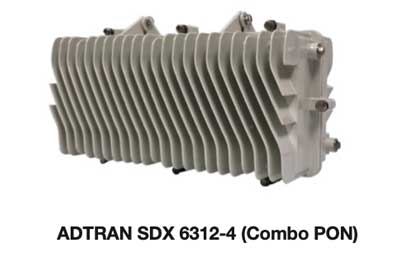
ADTRAN

Calix

Tellabs
We'll
try to get more information on these devces, especially
feedback from actual users, for future newsletters. (If
you are using these, contact us!)
Smaller Connectors For Prefab Drop Assemblies
Connectors on prefab drop cables have always been large
which makes installation and storage harder. Two new
connectors are aimed at reducing the size of hardware
needed for subscriber drops in a FTTH cable plant. Both
are about half the size of earlier connectors and are good
to reduce clutter and simplify drops.
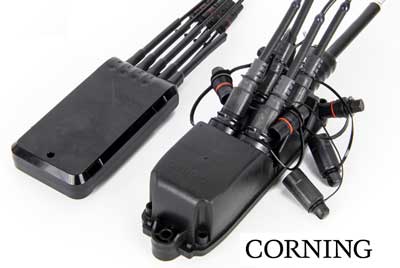
Corning
Evolv(TM) Connectors: Note
the size compared to the earlier designs on the right.
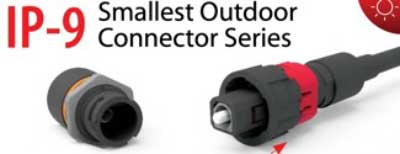
Senko's
IP-9 connector is a similar size - note the size of
the SC connector body on the right.
Cable
Marking Mystery
You are
all familiar with the information printed on a typical fiber
optic cable which includes the manufacturer, how many fibers
in the cable and distance markings, plus sometimes other
information like the manufacturer's part number.
But recently two people made reference to the small symbol
that looks like an old-style telephone handset. One thought
the manufacturer of the cable used that symbol to show where
the helical winding of the buffer tubes reversed, a
reference point for preparing the cable for midspan access.
Another thought it was to indicate this was a telecom cable
not a power cable.

FOA has been reaching out to people at cable companies to
see if anyone has a definitive answer as to what this symbol
means, and the answer comes from Rodney Casteel and his
engineers at Commscope.
"The handset symbol is mandatory for cables “suitable for
direct burial applications” per ICEA 640 and Telcordia
GR-20. I think this handset symbol started a long time
ago so data cables could be identified if they were dug up.
My guess is the first standard to mandate this was Telcordia
GR-20 Issue 1 back in the 80s."
From ICEA-640:

And Bellcore/Telcordia GR-20:

850nm
LEDs Extinct?
Two
equipment manufacturers told us this month that they could
not get 850nm LEDs - leadtimes were long and prices very
high. These LEDs are needed for multimode test equipment. In
transmission equipment, 850nm VCSELs are good subsititues,
but test equipment needs the more consistent, less coherent
light from the LED.
Communications
Systems Grounding Rules: NEC Article 800 provides specific
requirements
In the
March issue of Electrical Contractor magazine, Michael
Johnston, the NECA Executive Director of Standards and
Safety wrote an excellent article on grounding and bonding
for communications systems.
"Communications
systems and equipment installed in buildings must comply
with the specific rules given in Chapter 8 of
the NEC . Even though these systems typically
operate at lower energy levels, improper grounding and
bonding can result in severe consequences for equipment
and property and present shock hazards. Article 770 and
the Chapter 8 articles of the NEC provide unique
and specific grounding and bonding requirements for
communications system installations."
Anyone
installing low voltage systems needs to know about
grounding and bonding and Michael's article is an
excellent introduction to the topic.
Communications
Systems Grounding Rules: Article 800 provides specific
requirements by Michael
Johnston, NECA Executive Director of Standards and
Safetyin EC Magazine
Worst
Technical Boo-Boo Of The Month (May)
In an
article in a major magazine by a manufacturer of fiber
splicers: "‘ Under the wind cover is the area called
the fusion chamber - where the magic happens. Two pieces
of hollow glass are melted together, preserving the hole
so light can pass through it.‘
"HOLEY smokes...."
Midspan
Access - Simplifying Installation Of Drops
Technical
questions we get here at FOA often remind us of things many
of us take for granted that are not known by many installers
and particularly network owners and users. Recently we
received an email like this from a network owner working
with a contractor on a 15mile (25km) cable plant with
roughly 17 locations where cable drops were needed. They
were not aware of the technique of midspan access, so we
created a new page for the FOA Guide on the subject (FOA
Guide Page on Midspan Access), a YouTube
video and a Fiber
U MiniCourse.
Try
The FOA's Online Loss Budget Calculator
FOA has
written many articles about loss budgets, something everyone
involved in fiber optics needs to know and needs to know how
to calculate. We've created a online Loss Budget Calculator
that does the work for you. Just input your cable plant data
and it calculates the loss budget. It works on any device,
especially smartphones and tablets for field use and even
allows printing the results.
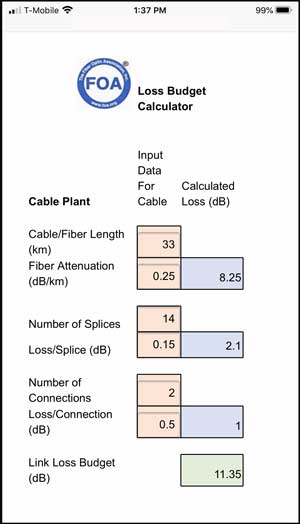
Bookmark
this page (especially on your smartphone): FOA
Loss Budget Calculator Online
|
Worth
Reading
Each
month we read hundreds of newsletters and online articles.
These are the ones we think you will find "worth reading."
|
Worth
Reading: July 2021
Community
Networks notes that community-owned and operated
broadband networks have topped PCMag's annual "Fastest
ISPs in America" analysis for three years running,
poking holes in arguments that modern network infrastructure
is too complicated or costly for local communities to build
and operate successfully.
Municipal
Broadband Advocates Win Major Victory in Ohio as
the lawmakers turn down an amendment to the state budget
that would ban municipal broadband networks. Community
Networks
Technical
Standards For OSP Installations from the
Communications and Information Technology Commission of
Saudi Arabia. Very thorough, easily understood. Courtesy FOA
instructor Tom Collins.
Scenes
From California’s Sugar Fire - The Atlantic.
Look at photo #7 and imagine your aerial cable under those
conditions.
Knoxville
Utilities Board Set To Build Largest Municipal Fiber
Network In The Nation The Knoxville City Council
unanimously approved a proposal to build a fiber-to-the-home
(FTTH) network. Network construction is expected to cost
$702 million and take seven to 10 years to build out,
reaching 210,000 households. Community Networks.
Muni
Broadband Wave Washes Across Massachusetts
Muni Broadband Wave Washes Across Massachusetts. Community
Networks.
Worth
Reading: June 2021
Lightwave
Magazine is back after many years as only a
online newsletter.
To
Fill Millions of Open Jobs, Many Workers Need More Than
Skills (NYTimes) Helping people land good jobs
with career paths takes more than skills training, labor
experts say. Coaching, mentoring and other assistance are
also needed.
Traditional
Federal Money Drying Up For Rural Broadband “We’re
taxing the telephone networks to pay for the broadband
network,” said Brendan Carr, a Republican member of the
Federal Communications Commission. “That’s like taxing
horseshoes to pay for highways.” Read
more from Bloomberg.
Worth
Reading: May 2021
China
starts large-scale testing of its internet of the future
China launched a large-scale experimental network in Beijing
on Tuesday to test the future of internet technology over
the next five to 10 years.Headquartered at Tsinghua
University, the “future internet technology infrastructure”
connects 40 of the…
Read in Apple News from South
China Morning Post: https://apple.news/A64XeyG2gRuGB1E63LAeqjw
Ransomware
attack leads to shutdown of major U.S. pipeline system
Washington Post. The attack on top U.S.
operator Colonial Pipeline appears to have been carried out
by an Eastern European-based criminal gang. Are you sure
you want that critical system connected to the Internet?
NeoPhotonics
Announces Cumulative Shipments of 2 Million Ultra-Narrow
Linewidth Lasers for Coherent Transmission Systems
That's a lot of coherent systems!
The
federal government is rolling out record amounts of
broadband funding. It could be just the beginning.
The federal government is starting to disburse more than $10
billion to bring more Americans affordable Internet.
Washington Post
Communications
Systems Grounding Rules: Article 800 provides specific
requirements by
Michael
Johnston, NECA Executive Director of Standards and
Safetyin EC Magazine

Summer
2021 Edition - the "Call Before You Dig" magazine.
Statistics
on US Labor In Telecom
Eric
Pearson sent us some links to US Bureau of Labor Statistics
data on the US Workforce. Granted it was updated in May
2019, but has lots of useful and interesting information on
where the work is and what workers are paid.

Read
the reports here:
Telecommunications
Line Installers and Repairers (Install and
repair telecommunications cable, including fiber optics.
Telecommunications
Equipment Installers and Repairers (Install,
set up, rearrange, or remove switching, distribution,
routing, and dialing equipment used in central offices or
headends. Service or repair telephone, cable television,
Internet, and other communications equipment on customers’
property. May install communications equipment or
communications wiring in buildings.
1995-2020
- FOA's 25th Anniversary!
As part
of celebrating 25 years of serving the fiber optic industry
as its primary source of technical information and
independent certifying body, FOA thought it appropriate to
create a short history of the organization and how it has
developed to help the fiber optic industry. We also
wanted to recognize the contributions many people have made
to the organization over the years that made FOA what it is
today.
The FOA history is now archived on the FOA website where
you can read it anytime or link to it.
Updated
info - dB, total internal reflection and science projects,
Worth
Reading - News Summary - Past Links Worth Repeating
Recycling
Fiber Optic Cable - Contact:
Steve Maginnis
LD4Recycle/ CommuniCom Recycling
(Visit
website)
sm@LD4Recycle.com
803.371.5436
Communications
Systems Grounding Rules: NEC Article 800
provides specific requirements -
Electrical Contractor Magazine
Sumitomo's
Ribbon Splicing Guide - download from
one of the leaders in splicing.
"Who
Lost Lucent?: The Decline of America's Telecom
Equipment Industry"
This is a MUST READ for managers in telecom or any
industry!
This
long and well-researched and annotated article in American
Affairs Journal should be mandatory reading for every
high level manager in a telecom company - or any other
company for that matter. To summarize the article, today,
America has no major telecom equipment company and fears the
major suppliers of equipment who are all foreign, especially
the Huawei from China. This article explains how America got
into this deplorable state.
OFS
also has an excellent website and blog of tech articles
worth browsing.
IEC
60050 - International Electrotechnical Vocabulary -
An extensive dictionary for fiber optics in English and
French. Highly technical - this is one definition: "mode -
one solution of Maxwell's equations, representing an
electromagnetic field in a certain space domain and
belonging to a family of independent solutions defined by
specified boundary conditions"
If
you are interested in restoration - aren't we all? -
you should also read this article in dpPro magazine by
FOA President Jim Hayes: Damage
Protection Requies Looking Overheas As Well As
Underground - dpPRO Magazine - about the
problems with aerial cables. His previous article for
the magazine was New
Techniques for Fiber Optic Installation.
How
much fiber optic cable is manufactured each year?
CRU Reports - unsurprisingly China is by far the largest
market today
The
Institute
for Local Self-Reliance weekly newsletter has
lots of interesting articles and links.
The Open Technology Institute at New America just
published “The
Cost of Connectivity 2020,”
US
Ignite and Altman Solon issued “Broadband
Models for Unserved and Underserved Communities”
Universal
access to broadband is a cornerstone to a strong
economy, Achieving universal access will require
community partnerships. by Alfreda
B. Norman, Sr. VP, Federal Reserve Bank of Dallas
FIBER
TO THE FARM: The co-ops that electrified
Depression-era farms are now building rural internet. Be
sure to check out the high-tech equine installation
equipment.
Next
Century Cities Newsletter - News from cities
around the US including Detroit and New York plus small
Infrastructure
Get Some Respect, NY TImes "On Tech"
"The magic of the internet requires a lot of very boring
stuff behind the scenes. "
DIRT
Report On Damage To Utilities
Common Ground Alliance (CGA) annual DIRT report provides a
summary and analysis of the events submitted into CGA’s
Damage Information Reporting Tool (DIRT) for the year
2018. The complete report is available for download
here. In addition, there is an interactive
dashboard that allows users to filter the data
more by factors contributing to damages.
Structured
Cabling News - a website and weekly
newsletter about cabling.
The
Internet Master Plan for New York City.
The New York City Internet Master Plan is a
comprehensive framework for the infrastructure and
services that provide connectivity to New York City
residents and businesses. This Master Plan will guide
City actions and public-private partnerships to
transform New Yorkers’ access to this essential
infrastructure for generations to come.
Fiber
Trivia From Corning.
The
Future Of Work Is Skills - So Stop Worrying About
Degrees - The
reality is the future of work is about skills, not just
degrees. (FOA Newsletter Feb 2020)
The
job market is hot. So why are half of U.S. grads
missing out?
VIAVI
Books On Fiber Optic Testing (2 volumes) - They're back!
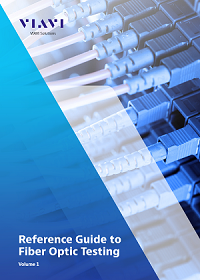
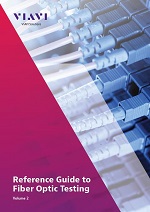
Besides
the FOA reference materials, two JDSU/VIAVI textbooks,
Reference Guide to Fiber Optic Testing, Volumes 1 and
2, were used as references for some of the FOA courses
and are recommended for instructors and students. The books
are available from VIAVI as eBooks and the everyone should
download them and recommend them to others.Download yours
now. Volume
1. Volume
2. Viavi Books
Guidebook
To MPO Testing OptoTest
offers this complete guide to MTP®/MPO testing. In this
guide, you will learn all there is to know about the
different test methods, equipment options,
troubleshooting, and best maintenance practices to ensure
that you have the best testing experience.
Go
here to download the book.
50th
Anniversary of The Development of Low Loss Fibers
A history of the development of low loss fiber, a
fascinating story by Jeff Hecht on the OSA (Optical Society
of America) website.
How
OFS Makes Fiber
Interesting YouTube video on how fiber is made. Perhaps a
little too much "show biz" but fascinating. If you have ever
seen fiber manufacture, look at this video. You will be
amazed at how big preforms have become!
How
Nexans Makes Copper Cables - compare the process
to fiber - don't most of the machines look similar?
The
True Cost of Telco Damages (what backhoe fade or
target practice can cost)
Rural
Electric Cooperatives: Pole Attachment Policies and
Issues, June 2019.
Clearfield-FOA
Certification Training Clearfield is now
offering their customers an FOA
CERTIFICATION course. This course provides
a basic understanding of fiber optic technology, as well
as Clearfield product knowledge and how Clearfield’s
integrated product systems work together in a fiber
network.
Substandard
Contractors - Fiber Optic Knowledge Doesn't Always
Trickle Down (EC Mag)
Another
Source Of Articles On Fiber
FOA
President and editor of this newsletter Jim Hayes has also
been writing a column in Electrical
Contractor Magazine for almost 20 years now.
Electrical contractors do lots of fiber work and this column
has covered some topics they are interested in including
installation processes, network design, fiber applications
and a lengthy series on dark fiber - what it is, how's its
used and how it benefits the growth of communication. A
recent web site redesign makes it easier to browse all these
articles - just go to http://www.ecmag.com/contributing-authors/jim-hayes
and you can see all of them. |
Q&A
Tech
Questions/Comments From FOA Newsletter Readers Worth
Repeating
The
FOA Fiber FAQs
Page (FAQs = frequently asked questions) gathers
up questions readers have asked us (which first ran in
this newsletter) and adds tech topics of general
interest.
|
Good
Question!
The
FOA Fiber FAQs
Page (FAQ s = frequently asked questions) gathers
up questions readers have asked us and adds tech topics
of general interest.
Questions
From FOA Newsletter Readers
June 2021
Using FOA Resources To Learn
Q: I've been working in this industry since October
2018. Started as a Field Service Engineer fielding aerial
and underground. I have since become a Project Engineer
working with aerial OSP and ISP. What is the catch? This is
just an amazing platform to continue with for me. It's been
all about the OJT, but this is just a great resource for me
now and the YouTube videos allow me to watch your videos
from today as well as 10 plus years ago.
How can I use the website to benefit me? Where should I
start? I just want to watch every YouTube video before I
focus on your website, but maybe I want to do both,
Suggestions?
A: FOA has three options to get information:
FOA Guide
is the FOA knowledgebase, ~1000 pages of technical material
generated by the FOA technical advisors around the world.
The link is to the Table of Contents where you can find
pages on just about any topic in fiber optics from fiber to
coherent communications. Every year about 1/2 million users
download about 4 million pages!
Linked from the Guide above is the FOA YouTube channel which
you have found. It’s over 100 videos, about 60 lectures on
tech topics, where you can get very familiar with my voice -
I’m the lecturer. The FOA videos are listed here:
https://foa.org/tech/ref/contents.html#YT
You can also go to the FOA channel on YouTube: go to the FOA
Channel “thefoainc"
Fiber U
is our free online learning site. We started online learning
at Fiber U in 1997. Today it has over two dozen free online
self-study courses that lead to a Fiber U Certificate of
Completion. Courses include Basics of Fiber Optics with an
accompanying Basic Skills Lab, where many people start,
especially if they are aiming at FOA CFOT certification, the
primary certification from FOA.
We also have basic courses on premises cabling, OSP
construction and installation, splicing, termination,
testing, network design and about a dozen that cover
specific applications. The FTTH course was developed when
Verizon approached FOA in 2005/6 to help with the rollout of
FiOS - training and recruiting installers.
FOA”s problem is we have too much “stuff”! It’s so much it
can be confusing on where to start. We generally recommend
going to Fiber U and picking courses that are important to
your work. Those courses will lead you to the appropriate
pages in the FOA Guide and videos on YouTube.
But we are always here to help. Tell us what you are
interested in and we can point you to the right places
(often including websites of manufacturers of products who
also have immense amounts of applications information.)
We’re
now working on a “Roadmap” to help people find their way,
but that will take time, there are a lot of paths to
connect!
Slow
Internet After Conversion From DSL To FIber
Q: Could you please help me understand why I am
getting a slow connection (the same as when I was using
anADSL box and sometimes even a bit slower) while having a
fiber optic connection to my home (FTTH then RJ45 between
wall & iMac)?
I am using an old iMac from early 2009 but the cable needed
is a regular RJ45, so I do not see why it should not take
the high speed connection...
As a matter of fact, it still takes several seconds (3 to 6
or even 12) for some pages to load...
A:There are several possible reasons your Internet is
slow loading pages.
The fiber optic link to your residence may have little or
nothing to do with the speed you see. If you use a speed
test to check the speed of the connection, it’s probably
going to show faster speeds, but it generally only tests the
connection to your ISP - Internet Service Provider - not to
the Internet or a remote data center. The actual
connection to the data center sending you the pages you
request may be hundreds or thousands of km long and through
many switches, so that could affect the speeds.
The major problem we see is the speed of the connection of
your ISP to the Internet. If they have many subscribers, the
“traffic jam” is at their connection. This is generally easy
to see over the time of day. In the evening when many people
are streaming TV or movies, it sends to get much slower,
just like automobile traffic during rush hour. At times when
fewer people are online, speeds will be faster.
We have exactly the same problem here in Santa Monica. Our
Internet over a cable modem tests at 100-200 Mb/s but pages
are slow loading because so many people are on the network
at once.
However, I also suspect your 12 year old iMac. The
typical web page is more complex than a decade ago and may
contain hundreds of files including graphics that have to be
downloaded and assembled for you to see the page.Newer
computers are much faster and software is more efficient at
handling large pages.
Seal End Of Cable
Q: For aerial OSP cable, are there any problems with
leaving the end of the cable open or should it always be put
into a closure of some kind?
A: The open end of the cable allows moisture to get
into the cable and can be a problem.
I see several scenarios here. If the cable is installed and
waiting for splicing, it could be a matter of time. If the
work is to be done soon - a week or two - leaving it open is
OK, but if the time is longer or you prefer being careful,
just seal the end of the cable by wrapping it with plastic
electrical tape. The end will be opened up for
splicing; about 2m of cable needs to be stripped to
splice it, so a few days exposure is OK, but long term we’d
recommend a simple tape seal, the way manufacturers do when
shipping cable on a reel.
May 2021
Gloves
for Fiber Techs
Q: I was wondering if as part of the safety rules, in
addition to glasses, if it is recommended to use gloves.
If that the case, would you recommend a specific type of
gloves.
A: FOA emphasizes the need for safety glasses
because of the problem with fiber scraps flying around,
especially when students in class are learning to strip
fibers. Proper safety glasses have side shields that provide
more protection than regular eyeglasses. For eyeglass
wearers, prescription safety glasses are available at very
reasonable costs that are much more comfortable to wear than
wearing safety glasses over the user’s prescription
eyeglasses.
We only recommend gloves when working with cables that have
sharp metallic armor in them or some heavy outside plant
cable. The metallic armor can cause serious cuts if one
slips when splitting or removing it. The gloves to use are
the kevlar gloves used to prevent cuts (they are also used
for chefs working with sharp knives.)
Once the cable is opened and you are dealing with buffer
tubes or bare fibers, gloves like the ones used for cables
can make the work difficult because gloved hands are clumsy.
Tight surgical rubber gloves might work for some, but still
make working with bare fiber difficult and provide limited
protection. There we recommend bare hands and being
very cautious.
April 2021
Multimode
In Premises Cabling
Q: I wonder when/if single mode fiber will start
invading the enterprise. There's a whole ecosystem, of
course, in addition to physical fiber cabling.
Switches, server connections, protocols, etc. But I'm
wondering if you see the industry moving towards some set of
standards using single mode?
A: Today,
singlemode transceivers are as cheap as multimode for 10G
and cheaper at higher speeds. Indoor cell systems (DAS) use
singlemode. FTTH PONs (passive optical networks using
singlemode) are being used for LANs because they are cheaper
too. Both technology and costs point to the advantages of
SM. Multimode is the historical design and it's hard to
change. But structured cabling standards (TIA-568, ISO
11801) include singlemode and POLs (passive optical
LANs.)
February 2021
Documenting
Test Results
Q: We’re currently working on a bid that includes
presenting some test sheet documentation for OTDR &
Light loss testing. What should I do?
A: High end LSPM or OLTS should store data and have
some software to report test results. Simpler units should
simply require logging data into a spreadsheet showing Cable
ID, Fiber ID, wavelength and loss. Details like launch &
receive cables and test results can be kept separately on
the spreadsheet. Today’s OTDRs will show you a trace and an
event table that lists each even in the fiber tested as well
as overall loss. Whatever OTDR you use should have software
for reporting test results. Here is an example of a report
from an EXFO and a trace from a Yokogawa.
Installing Cable
Q: Below are specs for an installation. We’ve never
installed a Fiber Optic run this long. Please see below
questions and info.
-Fiber Optic cable to be used is a 24 strand Single Mode
application
-Length of run is 7200 m long
-Appears that all the Fiber is on one reel. However do you
recommend having some junction points on pedestals along the
way for testing-maintenance purposes or just one continuous
run if possible?
A: FOA has lots of information to help answer your
questions:
Re underground installation. See https://foa.org/tech/ref/OSP_Construction/Underground_Construction.html
and https://foa.org/tech/ref/OSP_Construction/Underground_Installation.html
in the FOA Guide.
There are other questions you need to ask:
Are there no intermediate connections or drops required?
It’s just one straight fiber run? You should be able to
install it continuously.
What is the installation type? Pulled in conduit or direct
burial?
If pulled in conduit and you can pull in one try, that’s
best. You should use a pulling capstan to limit tension,
attached to the cable with a breakaway swivel pulling eye
and use lubrication. Use the American Polywater guides (https://www.polywater.com/product/polywater-f-fiber-optic-pulling-lubricant/)
for choosing lubricant and decide if you need an
intermediate pull.
Direct burial is simple for a long run, just ensure you have
the proper equipment.
January 2021
Maintaining
Dark Fiber
Q: Do you have any standards that speak to how often
dark fiber should be tested with OLTS and OTDR? Such as just
at installation and when troubleshooting, or should they be
done on a regular basis?
A: We at FOA know of no standards calling for
periodic testing of fiber optic cable plants.
Fiber optic networks generally do not require maintenance
and it is often detrimental to the network. It is the
opinion of FOA and most people in the industry that testing
should be done upon completion of the installation and data
submitted to confirm proper installation of the cable plant.
Data should then be stored for reference in case of problems
requiring troubleshooting or when new dark fibers are turned
up. Before lighting a dark fiber, it should be tested and
the results compared to earlier data. Since both tests have
some uncertainty, test results can vary as much as 0.5dB on
short cables, higher on longer runs.
If older fiber is being upgraded to higher speeds, now
cities like Santa Monica where we live are upgrading to 100G
networks, fiber characterization including chromatic
dispersion, polarization mode dispersion and spectral
attenuation (for DWDM) are advised. Of course, every time a
connection is opened, it should be inspected and cleaned.
And patchcords should be tested; even new ones in sealed
packages are often dirty. There is a reason people call the
plastic protective caps on connectors “dust caps!”
Otherwise, with fiber, we suggest the patch panels be locket
to keep unauthorized personnel from accessing them and
causing problems. Even disconnecting a connector can add
dirt to the connections and cause problems.
December 2020
Are FOA Videos and Web Up To Date?
Q:
Are the videos on YouTube still relevant by today's
standards are are they out of date?
A: Excellent question. We’ve discussed this within
the FOA many times.
For example the live action videos on cable preparation,
termination, mechanical and fusion splicing and testing are
quite old by tech standards but the processes have not
changed in two decades. Preparing loose tube, armored or
tight buffer cables has not changed in over 20 years, nor
has adhesive/polish connector termination.
Prepolished/splice connector and SOC process are different
and those processes have been updated. Testing processes are
the same with the main difference being the automating of
OTDR testing. Manufacturers have dumbed-down OTDRs so well
that it seems few techs know how they work or how to read a
trace, evidenced by the results of the FOA CFOT
Certification exam where questions on OTDRs are the most
often missed.
We just did a review of the copper installation for the
Premises cabling (CPCT Certification) and that has not
really changed in three decades - since the introduction of
Cat 5 cable!
We review and update the technical pages in the FOA Guide
all the time. Look at the Table of Contents (FOA Guide-https://foa.org/tech/ref/contents.html)
and see how many pages have the NEW symbol, indicating
updates in the last couple of months.
Also FOA is adding YouTube videos (https://foa.org/tech/ref/contents.html#YT
) and Fiber U MiniCourses (https://fiberu.org) on many
topics regularly - monthly this year, covering new tech and
the topics we know are lesser-known or new to most techs.
And let us know if there are topics you think we should
focus on in the future.
Microscope Power For Connector Inspection
Q: What
power microscope do you recommend to inspect
singlemode/multimode in 1.25/2.5 format (ST, SC, LC)?
A: Microscopes
in the range of 100-400 power are available. Many people
assume higher power is best - and it is for examining
polishing results in the center of the ferrule - but lower
power helps inspect more of the ferrule for dirt when used
in the field before connecting or testing cables. We prefer
the lower power.
So for patchcord manufacturers, 400, field techs 100.
Patchcord manufacturers will undoubtedly use video
microscopes, most field tech the optical ones.
November 2020
Loss For APC vs UPC Connectors
Q:
I was wondering if there will be a standard connector loss
for a UPC connector and a different lower value for an APC
connector.. ex. upc has 0.5dB while APC is 0.3dB.
I would like to make all connectors uniform on a new network
infra to avoid mismatch and causing any possible damage on
the equipment when APC will be plugged into to a flat.
A: There is really no statistical difference between
APC and UPC connector loss. The lower reflectance of the APC
actually reduces loss since the reflectance represents a
factor in connection loss, This issue of connector grades
has been discussed at international standards committees for
years. ISO/IEC wants to have grades of connectors, rated for
connector loss in ranges from 0.1 to 1dB, but I do not think
it’s standardized. I recommend using 0.3-0.5dB for loss
budgets, where in OSP networks it matters little, since
there are only a few connections and fiber and splice loss
is a larger factor.
Keeping UPC and APC connectors straight is easy - APCs are
Green, UPCs are blue. Everybody just needs to be taught
that!
OTDRs - Launch Cables And Range
Q:
I have a question about OTDR launch cables. In
all readings about OTDR testing, it states that the launch
cable "needs to be of sufficient length ...". What
length is sufficient? How long should a launch cable
be? What is the maximum length of cable plant that can
be tested at one time?
A: OTDR launch cables need to be long enough to allow
the OTDR to settle down after the test pulse leaves the
instrument and reflectance at the output connector overloads
the receiver. The dead zone is a function of the OTDR test
pulse and the condition of the output connector. If you are
testing short cables (<1km) with very short test pulses,
a launch cable can be 20-50m long. If you are testing a very
long cable with very wide pulses (some OTDRs have pulses
~4microseconds long, equivalent to ~1km) you would need a
2-5km launch cable. So the answer to that question is it
depends on how long the fibers are you are testing.
As to how far a OTDR can reach, the answer is generally not
specified in km but in dB. The best OTDRs have a reach of
~40dB at 1550nm which corresponds to ~150-200km, spending on
how good the splices are. That length of fiber would have
~30 splices for say 3dB splice loss.
Here’s the FOA
Guide page on OTDR testing and the FAQs
page Frequently Asked Questions about OTDRs.
October 2020's Newsletter article about the installation
of a 6912 fiber cable in small conduit prompted a
number of this month's questions on social media. And there
were more too.
Re: Installation
of a 6912 fiber cable
Q: For this post, "Tight Fit: 6912 Fiber Cable
Pulled in 1.25 inch Conduit”, he asks if they can see one
end completely terminated?
A: It takes about 2 full racks of patch panels or one
rack of splice trays. Sumitomo shows the splicing rack here
https://global-sei.com/data-center-solutions/splicing-rack.html.
Most systems using these cables will buy fully populated
patch panel racks with a splice rack for the cable to splice
to 6912 fibers terminated in the rack.
Q: And a second question:: How long does it take to
terminate? And over how many panels?
A: A very experienced tech can splice one of these
cables in ~75-100 hours using ribbon splicing.
Q: I assume that's smaller fiber like 80 micron
cladding
A: All the fibers in the high fiber count cables are
made with regular singlemode fiber - 9/125micron. TO make
the cables smaller, the buffer coating diameter is reduced
to ~200microns to make the fibers smaller.
Q: How was it prepared with the splice tray and ODF?
It might require a dedicated panel and splice tray.
A: It takes about 2 full racks of patch panels or one
rack of splice trays. Most systems using these cables will
buy fully populated patch panel racks with a splice rack for
the cable to splice to 6912 fibers terminated in the rack.
Q: Is this an actual photo or was the cable installed
in a different type conduit.
A: We were told that is the actual size of the cable
and conduit although not of the actual installation
discussed.
Q: What is the minimum bend radius of that cable?
What procedures did they use to maintain that bend radius
through those 90 degree curves?
A: The minimum bend radius is 15X the cable diameter
for that cable (diameter 1.14” or 29mm), about 17” or
435mm. The conduit bends had to be controlled to be larger
than that radius. See the Fiber U MiniCourse Fiber
Optic Cable Bend Radius

Preparing Cable For Splicing
Q: Is there any standard on the preparation length of
strip jacket upto the splice tray. Ideally its better to
have a loop of buffer before getting into the tray if ever
the closure has enough space for slack.. its also nice to
put some hose to the buffer to add on protection. So far, i
don't see any standard and can't support the remarks on what
to follow. The practice was to take note on macrobend and
have enough length of fiber to reach the machine.
A: There is a lot of variation in the size, shape
and design of splice closures, so the length varies
according to the closure and trays. For loose tube cable,
the length of buffer tube from the entrance to the splice
tray and the length of fiber needed in the tray are given in
the directions for that splice tray. Similarly for ribbon
cable, but the variations in ribbon cable designs often
requires special handling and sleeving for the ribbons. Most
manufacturers have specs available online.
Fusion Splice-On Connectors (SOCs) (From an FOA
Instructor)
Q: A question came up from one of our students
regarding splice on connectors. Is there a TIA or
other standards body that addresses this issue? We are used
to the 0.75 dB loss for a mated pair, however, when this
mated pair has two fusion splices that terminate the
connector, is there a recommendation?
One could make the argument that it does not make any
difference as the other alternative is splicing a pigtail
for termination of a cable. This pigtail splice is
normally included in the link loss budget
calculation. So similarly, with a splice on
connector it is the same as splicing on a pigtail.
A: There are no specific TIA or IEC specs that
address these splice-on connectors or pigtails. If you used
TIA numbers and included the splice and connector it would
be 1.05dB - 0.75dB for the connection and 0.3dB for the
splice, that’s mated to a factory adhesive/polish
connector. Or if it were two similar connectors,
1.35dB.
Everybody, including the people in TIA standards groups,
know those numbers are too high for most single ferrule
connectors. They keep them at 0.75dB for prepolished/splice
connectors (w/ mechanical splices) and array connectors
(MPOs) which have somewhat unpredictable performance.
Internationally, IEC has created grades of connectors from
~0.3 to over 1dB. The newer mechanical splice connector kits
now use the Chinese copied cleavers which are super - at
least the few we have tested - and the connectors are now
much lower loss and consistent.
SOCs (fusion splice-on connectors) are spec’ed as the total
termination and are generally just as good as the typical
adhesive polish connector - 0.5dB is plenty of margin for a
those mated to a factory adhesive/polish connector.
Spliced on pigtails are generally considered a termination
and the splice is not broken out - like a long SOC. But I
cannot guarantee everybody thinks that way. But a fusion
splice is typically <0.1dB anyway.

The
word on the "Dig Once" program is getting out - FOA is
getting calls from cities asking us for information and
advice. Here are some links:
The DoT page on the administration’s Executive Order: http://www.fhwa.dot.gov/policy/otps/exeorder.cfm
From the Council of State governments: http://www.csg.org/pubs/capitolideas/enews/cs41_1.aspx
From the city of San Francisco: http://sfgov.org/dt/dig-once
An article about Dakota County, MN: https://muninetworks.org/tags/tags/dig-once
And
the one to download and hand out:
A “How To” Guide from The Global Connect Initiative: https://share.america.gov/wp-content/uploads/2016/04/6.-GCI-Dig-Once.pdf
Fiber Optic Cable Plant - The Finished Product 4/2020
In
April, FOA received inquiries from several sources that all
deal with the same subject - what is involved in the
specification and acceptance of a cable plant at the end of
a installation project. And what are reasonable
specifications for a cable plant.
FOA has a lot of documentation on a project involving
designing and installing a cable plant in the
FOA Online Guide and our Textbooks, but the acceptance
process has usually been relegated to a few paragraphs. We
decided to add a page
on project "Deliverables" in the FOA Guide that covers
this topic in more depth. This page looks at a project, goes
into some depth on loss budgets and includes links to FOA
tech documents to help you investigate further.
Correction: In the article, the original list of fiber
specs for G.652 was wrong. It should be 0.4dB/km @ 1310nm.
Deliverables
in the FOA Guide
Is
There A Standard For Fiber Optic Installation?
Another
question we get often is "Is there a standard for fiber
optic installation." The answer is yes, but not from the
usual standards groups you might expect. Over 20 years ago,
the National Electrical Contractors Association (NECA) asked
FOA to help create a standard for installation. That
standard, ANSI/NECA/FOA-301 has been updated three times
already and is about ready for another update.
Unlike most of those groups who charge you a fortune for
standards, FOA covers the cost so ANSI/NECA/FOA-301
is available free from FOA.

Download
your free copy of ANSI/NECA/FOA-301
here (PDF)
Older
questions are now available here.
|
Training /
FiberU
News and resources to help you learn more and stay
updated.
Find
a listing of all the FOA-Approved schools here.

Free
online self-study programs on many fiber optics
and cabling topics are available at Fiber
U, FOA's online web-based training website.
Free
online training at Fiber U
The
FOA has >100 videos on  |
Welcome
New
FOA Approved Schools
School
388: Global Com of Sterling, Virginia, USA
School 389. CWA-JATC Telecom Training Center, San Jose, CA
School 390 Northern Allied Communications, Nespelem,
WA
School 391 Lewis-Clark State College, Lewiston, ID
School 392 Wallace Community College, Dothan, AL
For information on these new FOA-Approved Schools and a listing
of all the other schools, go here.
More
New Free Fiber U MiniCourses
Color
Codes For Fiber Optics
FOA has
created another Fiber
U MiniCourse, the Fiber
U Color Codes MiniCourse. This
course covers the color codes used in fiber optics. We cover
fiber color codes for numbering, cable jackets and
connectors used to identify fibers. After we finished, we
wondered "Why didn't we do this a long time ago!"
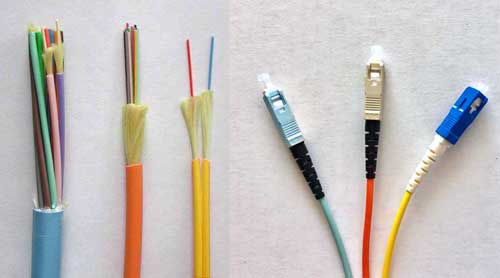
At the same time, we updated the FOA
Guide page on Color Codes with new information
and lots of color and created a new YouTube
video on Color Codes which we use in the Fiber
U MiniCourse.
Fiber
U Color Codes MiniCourse
How Fiber Works
Another
of the mysteries of fiber optics, like dB, is how optical
fiber actually guides light in the core of the fiber and
transmits it with low loss. FOA has several
pages in the FOA Guide on how fiber works with
animated graphics that illustrate the different ways step
index multimode, graded index multimode and singlemode fiber
work. We also have
YouTUbe video showing live demonstrations with a large
plastic rod simulating the core of an optical fiber.
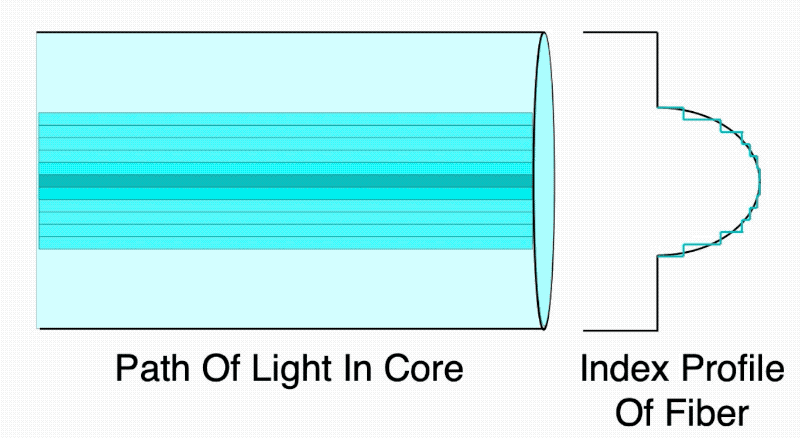
When we decides this was a good topic for a Fiber U
MiniCourse. we decided to create a new video lecture on how
fiber works. The lecture uses our usual lecture format but
with videos that animate the process of total internal
reflection and guided rays (modes) in the cores of the three
types of optical fiber.
How
Optical Fiber Works - Fiber U MiniCourse
More
New Fiber U MiniCourses

Got
An Hour Or Less? Learn Something New About Fiber Optics.
FOA has
introduced a new type of Fiber
U
course, the MiniCourse, a free online course you could take
in a short time, perhaps as you ate lunch at your desk or
took a coffee break. The
topics of these courses should explain what they are about,
and these are all very important topics to fiber optic
techs.
Fiber
Optics In Communications
How
Optical Fiber Works
Fiber
Optic Network Restoration
Fiber
Optic Connector Identification
The
Mysterious dB of Fiber Optics
Fiber
Optic Cable Bend Radius
Fiber
Optic Link Loss And Power Budgets
Fiber
Optic Connector Inspection And Cleaning
Fiber
Optic Media Conversion
Fiber
Optic Cable Midspan Access
Reading
An OTDR Trace
The courses have two components, video lectures and
readings, that are complementary. As usual there is a
self-test to allow you to check your comprehension. As with
other Fiber U courses if you desire, you can take a short
test for a Fiber U Certificate of Completion that costs
only $10.
All these free courses and many more are
available at Fiber
U.
What
Fiber Techs Don't Know -
What
We Learn From FOA Certification Tests
As FOA
moves more testing over to our digital online testing system
at ClassMarker, we have access to more data about our
testing, including what questions and topics on the tests
are answered incorrectly most often. Having this data gives
us an opportunity to evaluate the questions and how they are
stated, but more importantly it allow us to help our
instructors teach the subjects and us to change our
curriculum and online courses to emphasize these particular
topics. These are some of the topics that we have noticed
are answered incorrectly more often in FOA and Fiber U
tests.
Most of the questions missed are on testing.
1. OTDRs - particularly what information is in the OTDR
trace.
2. The difference between dB and dBm
3. Loss budgets - both the concepts and doing the math
4. Insertion loss testing - single-ended or double ended for
testing patchcords or cable plants, how to set 0dB
references
5. Units of measure - fiber is measured in microns,
wavelengths in nanometers, etc.
At FOA, we're working to add Fiber U
MiniCourses on these topics and working with our
schools to emphasize these topics in their classes.
If you are going to be taking a FOA certification course or
test in the near future, these topics should be on your
final exam study list.
What We Learn From Hands On Labs
We learn about students performance in hands-on labs from
the feedback of our instructors and our own experiences too.
One big problem is the use of hand tools. Growing up today,
you learn how to use keyboards, mouses and touch screens,
but decades ago, you also learned how to use basic hand
tools. This is big enough of a problem that we're
considering adding some video lessons on basic hand tools to
prepare students for cable prep, termination and splicing
that require the use of hand tools.
FOA
"Work-To-Cert" Program
Experience
Plus Online Study At Fiber U = FOA Certification
This
year, more techs have become comfortable with online
conferences, webinars and training. Many have discovered
that they can become FOA Certified using their experience in
fiber optics and study for the FOA certification exams
online at Fiber U.
Thousands
of industry professionals have applied to the FOA directly
for certification without the need for classroom training,
based on their knowledge and skills developed working the
field. Since FOA certifications are based on KSAs
(knowledge, skills and abilities), current techs already
show the skills and abilities required through their field
experience. FOA provides free online self-study
courses at Fiber U
for the knowledge part to prepare you for FOA certification
exams which you can also take online.
If you are an experienced field tech interested in
certification, and FOA is the internationally
recognized certifying body for fiber optics, you can find
out more about the FOA
"Work to Cert" program here.
If you are already a CFOT, FOA also offers many specialist
certifications you can obtain based on your experience as a
field tech. See what's available at Fiber
U.
Options
For Training Classes -
Social
Distancing and Masks

Outdoors
(11/2020)
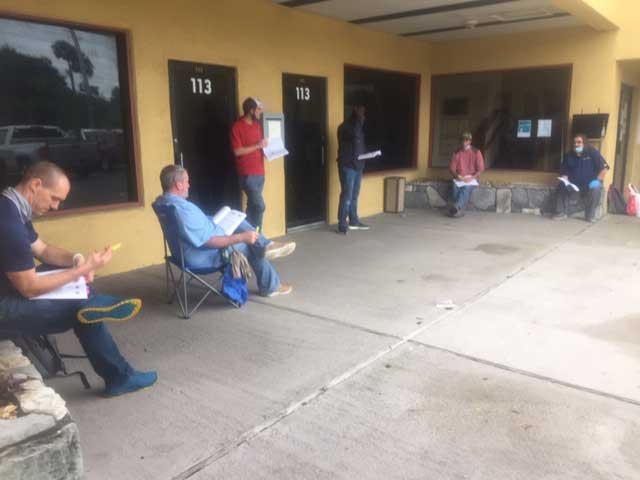
Tom
Collins, Techtricians, FOA Director, keeps exploring new
ideas for training. This time, the course moved outdoors in
Daytona Beach, Florida. This solution works well as long as
it's warm and dry!
DIY (Do-It-Yourself) Labs
Knowledge
is easy to get online, but learning skills requires
"hands-on" practice and that requires tools and
components to practice with. Here at FOA, we've been
working on an online course that could help many
techs learn new skills or improve others using an
online self-study course and their own equipment. Recently,
we have updated the materials in the Fiber
U Fiber Optics Basic
Skills Labs which includes cable
preparation, splicing, termination and testing.
And we have created a Basic
Skills Labs - Copper Premises Cabling to
cover UTP (Cat 5) and coax copper cable
processes. As with all Fiber U courses, these
are free.
Several times in the FOA Newsletter we've discussed
the Fiber
U Basic Skills Lab. This online DIY lab course
assumes you have your own equipment to use for the
labs, but most novices, unless they work for a larger
company already in fiber optics, will not have
equipment. FOA instructors have found a solution:
purchase inexpensive equipment online. What they have
found are many low cost tools and components that are
perfectly suited to training.
If
you do not have tools or equipment and want to
purchase them, there is a new
Fiber U DIY Basic Skills Lab lesson with
directions on how to purchase inexpensive tools
online and use them to learn basic fiber optic
skills. Those tools and components are what we
describe here.
For example, you need a fiber cleaver
for splices and prepolished/splice connectors. A good
cleave is essential for a good splice or termination
with a splice-type connection. Good cleavers are now
available online at prices in the US starting at
$20US.


Besides the cleaver, another really good tool for
learning or teaching is a visual fault locator. These
devices used to be very expensive, but now are
available online for $10-20.
Many online sellers offer sets of fiber optic tools in
a kit for very low cost.
With plenty of tools available online, the next things
you need are components to practice on. No problem
here either. You need a patchcord, some mechanical
splices and some prepolished/splice connectors. The
connectors and splices are available from online
sellers for ~$1 each, easy to afford plenty to
practice on.
FOA has used all these available parts together into a
do-it-yourself
hands-on lab as part of the Fiber U Basic Skills
Lab. You can do this yourself at a very low
cost. We
even provide directions on how to search for
suppliers of these tools and components.
Caution!
FOA has not exhaustively tested these tools or
components enough to recommend them for field use. The
work we did with them to create teaching labs shows
they are certainly good enough to use for teaching the
installation processes in a training lab. We suggest
read the buyers reviews and do some of your own
testing before using them for anything other than
training and practice.
FOA
Guide "Basics Of Fiber Optics" Now Available Online in
Portuguese (6/2020)

FOA has
now translated the Basics of Fiber Optics textbook in our
Online Guide into Portuguese, joining Spanish and French
translations. For those speaking Portuguese, we have the
technical information and for schools we also have
curriculum available.
Here
is the FOA
Guide in Portuguese,
Spanish and
French
translations.
Time
To Learn - Online - (Update 4/2021)
Ssome
schools have been closed during the pandemic, so FOA has
been working with them to create new online learning
experiences that can in some cases lead to certification
online. FOA certifications are still based on the KSAs -
knowledge from the classroom, skills from the labs and
abilities judged by instructors or proven by actual
experience.
ZOOMing
Much of what we're doing benefits from the capabilities of
"Zoom." Others have created videoconferencing apps, but none
work so well, especially with limited bandwidth. We've seen
remote labs that have an instructor showing students how to
use the tools they were sent then watching them duplicate
their actions. We have worked out methods to use Zoom to
proctor FOA's online certification exams.
Blended
Learning
While most FOA schools have suspended in-person training
during this period, some are offering a "blended
learning" option. That means that students sign up for a
FOA certification course, take the classroom sessions on
Fiber U with the assistance of a FOA certified
instructor. Now online instruction can include reviewing
the labs using the Fiber
U Basic Skills Labs, then when it's possible to attend
classes at the school, complete the hands-on labs and
take the FOA certification exam.
Offline Fiber U
FOA has also created offline Fiber U modules to allow
students with poor or limited Internet access to use
the Fiber U Basic Fiber Optics and Premises Cabling
programs without Internet access. Contact FOA for
information on using this option.
Online Remote Labs
Alternatively, some schools are experimenting with
"remote labs," where the students get sent tool kits
and components and labs are conducted by
videoconferencing. Before the labs, the students may
watch demos by their instructor on videoconferencing
and/or review the relevant "virtual hands-on" lessons
in the Fiber U Fiber
Optics Basic
Skills Labs so they will already know
the steps in the exercises. And
Fiber U has the new
Fiber U DIY Basic Skills Lab lesson
with directions on how to purchase
inexpensive tools online and use them
to learn basic fiber optic skills. Videoconferencing
allows the instructor to remotely monitor their
work and provide help as needed. Contact
the FOA for more information.
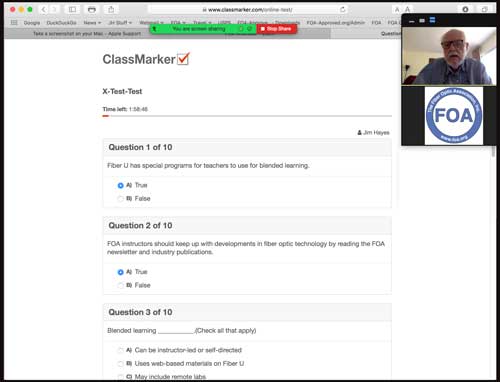
FOA Zoom Exam Proctoring
Online
Certification Testing
FOA has all its certification tests available
online, both for use by our schools and by our
direct "Work
to Cert" applicants. All FOA certification
tests require a proctor to oversee the applicant
taking the exam. In this time of social
distancing, getting a proctor can be difficult, so
FOA now has procedures for online proctors
administering the exam. Contact
the FOA for more information.
OJT - On-The-Job-Training
Many novices get a job and learn on the job. They
usually have an experienced tech who helps them gain the
knowledge and learn the skills they need to
perform their job. Thinking about this in relation to
the
FOA KSAs, the knowledge, skills and
abilities needed by a fiber optic tech, the tech
will learn skills but not the basic knowledge that helps
them understand the processes involved. FOA can offer
help here with our FOA's
OJT-to-Cert Program,
using our Fiber
U online self-study programs. While the tech
learns on the job, they become a Fiber
U trainee, getting the knowledge they need,
while working under their "mentor" at work. This is
particularly good for contracting companies who need
techs but do not have the usual training courses
available. Interested in OJT programs? Click on the
link below or contact FOA
for more information.
FOA's
OJT-to-Cert Program

FOA offers free online self-study programs at Fiber
U. Many users are preparing for FOA certification
programs - taking courses at our schools or using the "Work-to-Cert"
program. Some of our schools are requiring Fiber U programs
as prerequisites for their classroom courses so they can
spend more time on hands-on activities.
FOA
School Offers Toolkit With Online Training
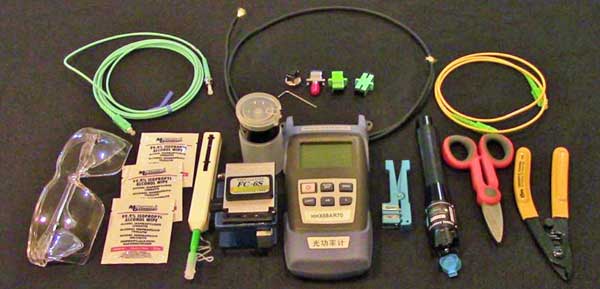
Slayton
Solutions (FOA Approved School #156) is offering a simple
fiber optic tool kit that includes a 29-piece set of fiber
optic tools and a power meter along with training videos
and online instruction for only $499. 29 Piece Kit
includes all tools and devices a technician needs to
install fiber optic connectors and test optical
power. Information
on the kit is available on YouTube.
You can contact them for more information at
slaytonsolutions@sbcglobal.net
or https://www.fiberopticsinstitute.com
|
Publications /
Resources

|
More
New FOA Video Lectures On YouTube
New
FOA
YouTube Video Describes On-The-Job Training (OJT)
And How To Use Fiber U To Make It Work Better.
To
explain How OJT works and FOA's OJT-To-Cert program, FOA
created a short 10 minute YouTube video that explains what
OJT is, who uses it and how to use Fiber U to organize and
enhance OJT for new employees and experienced workers too.
Lecture
62: On The Job Training For Fiber Optics Using Fiber U
As part
of developing the new Fiber U MiniCourses, we added several
new YouTube videos:
Lecture 56 explains the issues of cable bend radius
limitations, typical cable specifications and how to gage
the proper radius or diameter when installing or storing
cable. Lecture 57 covers problems with dirty connectors and
how to inspect and clean them.
FOA
Lecture 51 Fiber Optic Restoration
Part 1 - Causes of Damage To The
Network
FOA
Lecture 52 Fiber Optic Restoration Part 2 -
Planning For Restoration
FOA
Lecture 53 Fiber Optic Restoration Part 3 -
Troubleshooting And Repair
FOA
Lecture 54 Fiber Optic Connector Identification
- New and old
FOA
Lecture 55 The Mysterious dB of Fiber Optics.
- Understanding dB
FOA
Lecture 56 Fiber Optic Cable - Bend Radius
- Important for Installers to Understand
Like all our YouTube lectures, they are all short
and easy to understand.
Project
Management For Managers
While
this subject could take an entire book to cover or a long
class, we did not do that. We thought about it but decided
managers are very busy and what they want/need is a short
overview of the issues of managing fiber optic projects with
listings of available resources. We ended up with two pages
for managers: Guide
To Fiber Optic Projects and Fiber
Optic Project Management (For Managers).

The
FOA Guide
To Fiber Optic Projects summarizes what's
involved in a fiber optic project. Then it becomes a
resource guide, with links to other pages in the FOA Guide
that provide much more information on the details of a
fiber optic project. A manager can read the page in a few
minutes, familiarize themselves with the links to other
pages in the FOA guide that can be used for future
reference.
The page Fiber
Optic Project Management (For Managers)
page discusses the role of the manager in a fiber optic
project and makes recommendations on what the manager
needs to know and focus on to make a project successful.
Again, it's an overview but provides links to additional
resources that can be used as needed.
We encourage managers to use these two pages as resources
and give us feedback: What do you think is missing and how
can we make it better?
FOA
Loss Budget Calculator On A Web Page 5/2020
FOA has
written many articles about loss budgets, something everyone
involved in fiber optics needs to know and needs to know how
to calculate. We recently discovered how to get a
spreadsheet ported to a Web page, so we created this web
page that calculates loss budgets. We have an iOS loss
budget app, but with this web page, you can calculate loss
budgets from any device, smart phone, tablet, laptop, or
desktop computer that has web browsing capability.

Bookmark this page (especially on your smartphone): FOA
Loss Budget Calculator Online
 We are
continually updating the Online Reference Guide to keep up
with changes in the industry and adding lots of new pages of
technical information. When you go to the FOA
Guide Table of Contents to see the latest updates -
look for
We are
continually updating the Online Reference Guide to keep up
with changes in the industry and adding lots of new pages of
technical information. When you go to the FOA
Guide Table of Contents to see the latest updates -
look for  . .
Recent updates:
Color
Codes For Fiber Optics
Fiber
Optic Projects - the FOA Guide to projects from
concept to operation
10GPON
on PON Protocols in the FOA Guide.
Coherent
Communications Systems in the FOA Guide.
Updated
(and more illustrations): Basic
Fiber Optic Jargon, OSP
Fiber
Optic Jargon and Fiber
Optic Jargon for managers.
Fiber
Optic Network Restoration
Fiber
Characterization goes in to more depth, why fiber
characterization is important and how to interpret results.
Fiber
Optic Network Management for managers
FOA
has created a section on OSP
Construction and a Fiber
U course based on it.
FOA
Guide section on inspecting and cleaning connectors.
Go
to The
FOA Online Fiber Optic Reference Guide.
FOA Reference Books
FOA
Reference Books (Printed or Kindle eBooks!)









Fiber Optics (4 languages), Premises Cabling, OSP fiber and
construction, Network Design, Testing and FTTH
The
FOA has it's own reference books for everyone working in
fiber optics - contractors, installers and end users as
well as for use as textbooks in classes at educational
institutions. They are available as printed books or
Kindle at much lower prices than most textbooks since we
self-publish and sell online, cutting out the middlemen.
Click on the book images for more information. The
Reference Guide To Fiber Optics is also available in
Spanish and French (print and online) and Portuguese
(online only.)
Click
on any book for more information about it.

NEW: FOA's
FTTH Handbook: We've gathered all our
information on FTTH from the FOA Guide and past issues of
the FOA Newsletter and edited it into a 112 page "FTTH
Handbook." We even added a section on planning and managing
FTTH Projects.
The
Fiber Optic Association Fiber To The Home Handbook
is available from Amazon in print and Kindle
editions.
FOA has
reprinted

"Lennie
Lightwave's Guide" on its 25th anniversary in
a special print edition.
Lennie
and Uncle
Ted's Guides are online or as free iBooks on iTunes.


Click
on any of the books to learn more.
- Fiber
Optic Safety Poster to download and print
Resources
For Teachers In K-12 And Technical Schools
Teachers in all grades can introduce their students to
fiber optic technology with some simple demonstrations.
FOA has created a page for STEM or STEAM (science,
technology, engineering, arts
and math) teachers with materials appropriate to their
classes. Fiber
Optic Resources For Teachers.
|
Safety
|
On
Safety
FOA
considers safety an integral part of all our programs,
curriculum materials and technical materials. We start all
our textbooks and their online versions with a section on
safety in the first chapter, like this: Before
we get started - Safety First!
There are pages on the FOA Guide on Safety
procedures Including Eye Safety and. Digging
Safely
And a YouTube lecture: FOA
Lecture 2: Safety When Working With Fiber Optics
In our OSP Construction Section, these pages cover many
safety issues including those related to the construction of
the cable plant: Project
Preparation And Guidelines, Underground
Cable Construction, Underground
Cable Installation and Aerial
Cable Installation.
There is even a safety poster for the fiber activities: PDF
Safety Rules For Fiber Optics
The FOA is concerned about safety!
There
is a toll-free "call before you dig" number in the USA:
Dial 811
See
www.call811.com for
more information
The
Common Ground Alliance has an excellent "Best
Practices Guide" online
- The
US Department of Transportation has a website called "National
Pipeline Mapping System" that allows one to
search for buried pipelines.
Why
We Warn You To Be Careful About Fiber Shards

Photo courtesy Brian Brandstetter, Mississauga
Training Consultantcy
Safety
Leader Magazine
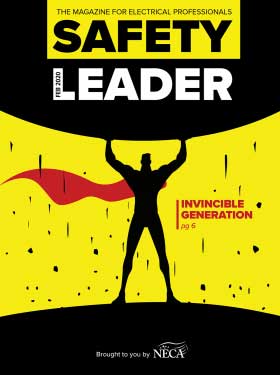
Safety Leader, a new quarterly magazine, informs and
educates electrical contractors on safety from various
angles—electrical, workplace, PPE, regulations, leadership,
line work, NFPA 70E, and more. Safety Leader is bundled with
ELECTRICAL CONTRACTOR in February, May, August and November.
To receive Safety Leader subscribe
to ELECTRICAL CONTRACTOR magazine here or subscribe
to the ELECTRICAL CONTRACTOR newsletter here.
2022
Conference On Damage Prevention In Phoenix
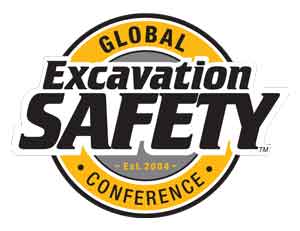
Global
Excavation Safety Conference
Phoenix
AZ
March
1-3, 2022
GlobalExcavationSafetyConference.com:
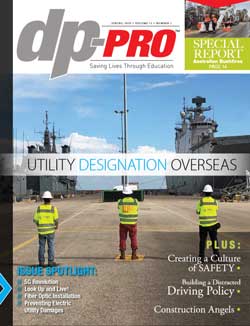
The magazine, dp-Pro, sponsor of the conference, has
also published it's latest issue with an article by FOA
on "New Construction Techniques in Fiber Optics" and a
overview of the FOA. You
can read the magazine here.
Best
Practices Guide For Underground Construction

We
assume you are familiar with the "One Call" and "Call
Before You Dig" (811) program, but are you also
familiar "Click
Before You Dig.com" and with the people behind
it - the Common Ground Alliance and their Best Practices
website?
Officially
formed in 2000, the CGA represents a continuation of the
damage prevention efforts embodied by the Common
Ground Study.
Sponsored by the U.S. Department of Transportation and
completed in 1999, this Study represents the collaborative
work of 160 industry professionals who identified best
practices relating to damage prevention. Any
best practice or program endorsed by the CGA comes with
consensus support from experts representing the
following stakeholder groups: Excavators, Locators, Road
Builders, Electric, Telecommunications, Oil, Gas
Distribution, Gas Transmission, Railroad, One Call,
Public Works, Equipment Manufacturing, State Regulators,
Insurance, Emergency Services and Engineering/Design.
Read
the CGA Best Practices Guide here.
Here
are all the CGA resources for damage prevention.
The
US Department of Transportation has a website called "National
Pipeline Mapping System" that allows one to search
for buried pipelines. |
FOA/About
About
The FOA
- Contact
Us: http://www.foa.org
or email <info@foa.org>

FOA
has a company page and four LinkedIn Groups
FOA
- official company page on LinkedIn
FOA
- covers FOA, technology and jobs in the fiber optic
marketplace
FOA
Fiber Optic Training - open to all, covers fiber optic
technology and training topics
Grupo
de La Asociación de Fibra Óptica FOA (Español)
|
What is The FOA?
The FOA is a, international non-profit educational
association chartered to promote professionalism in fiber
optics through education, certification and standards.
Founded in 1995 by a dozen prominent fiber optics trainers
and leaders from education, industry
and government as
a professional society for fiber optics and a source of
independent certification, the FOA has grown to now being
involved in numerous activities to educate the world about
fiber optics and certify the workers who design, build and
operate the world's fiber optic networks.
Read
More
FOA
is 25 years old this July - read about FOA's history in
this newsletter above.
Learn
More About FOA's History.
Contact
Us
The Fiber Optic Association Inc.
http://www.foa.org or email
<info@foa.org>
The
FOA Home Page

Want
to know more about fiber optics? Study
for FOA certifications? Free
Self-Study Programs are on "Fiber
U®." Looking for specific information? Here's the
largest technical reference on the web: The
FOA Online Fiber Optic Reference Guide.

Free
online self-study programs on many fiber optics and cabling
topics are available at Fiber
U, FOA's online web-based training website.
|
-
Contact
Us
The Fiber Optic Association Inc.
http://www.foa.org or email
<info@foa.org>
- Phone:
1-760-451-3655
The
FOA Home Page
(C)1999-2020,
The Fiber Optic Association, Inc.
|
FOA
Logo Merchandise
New
FOA Swag! Shirts, Caps, Stickers, Cups, etc.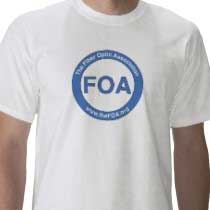
The FOA
has created a store on Zazzle.com offering lots of new logo
merchandise. It has lots of versions of shirts and other
merchandise with "FOA," "Fiber U," "Lennie Lightwave"
designs and more so you should find something just for you!
See FOA
on Zazzle.
-

Your
Name, CFOT® - It pays to advertise!
The
FOA encourages CFOTs to use the logo on their business
cards, letterhead, truck or van, etc. and provides logo
files for that purpose. But we are also asked about how to
use the CFOT or CFOS certifications. Easy, you can refer
to yourself as "Your Name, CFOT" or "Your Name, CFOS/T"
for example.
Feel
free to use the logo and designations to promote your
achievements and professionalism!
Contact
FOA at info@thefoa.org to get logos in file format for your
use.
Privacy
Policy (for the EU
GDPR): The FOA does not use cookies or any other
web tricks to gather information on visitors to our
website, nor do we allow commercial advertising. Our
website hosts may gather traffic statistics for the
visitors to our website and our online testing service,
ClassMarker, maintains statistics of test results. We do
not release or misuse any information on any of our
members except we will confirm FOA certifications and
Fiber U certificates of completion when requested by
appropriate persons such as employers or personnel
services.
Read
the complete FOA Privacy Policy here.
|





































































 .
.







